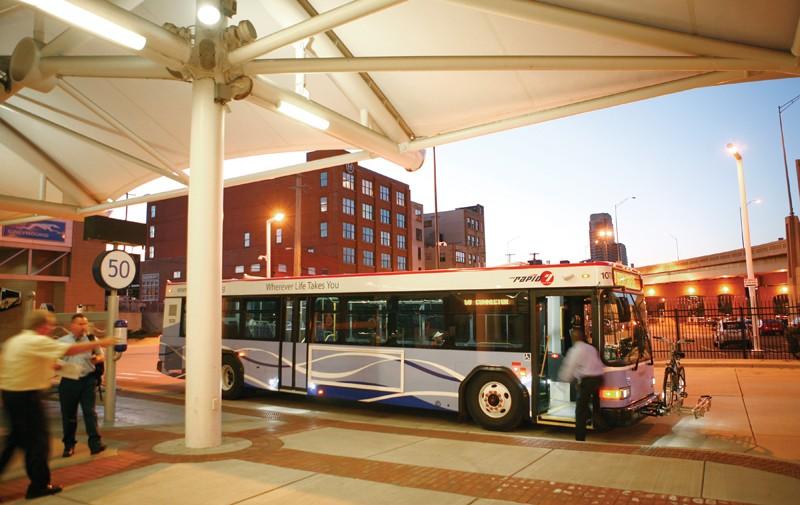Rapid transit rule changes affect GV student riders

GVL / Eric Coulter The Rapid Route 50, known as the Campus Connecter, now stops at the Rapid Central Station in the heart of Grand Rapids
Aug 29, 2012
Changes within the Rapid bus system, including extended route times and more frequent stops, have been going on for over two years, but are only the first few steps in a 20-year project meant to combat anticipated increases in gas prices and travel cost.
Some of those route and time changes became effective Aug. 27, the first day of school for Grand Valley State University students, when a total of 26,534 commuters came to and from GVSU on the bus.
Some student riders said the changes were not well-advertised and caused undue inconveniences.
“The only negative side to the bus change that I have experienced recently and heard other students reiterate is the fact that the 50 [route] now goes all the way to central station,” senior Taylor Moore said. “I and a packed bus of GV students made this mistake yesterday when the bus took us to the central bus station, making the bus ride nearly a 45 to 50 minute process. I think the fact that so many people made this mistake and were confused further proves that advertising about the changes is really important, especially since the 50 route is so important for GV students.”
Mark Rambo, Pew Campus operations manager, said the changes are meant to improve the quality of transportation experienced by the GVSU community. The adjustments are effected “to create seamless connectivity between the GVSU routes and the greater Rapid Network. All faculty, staff, and students now have direct access to the entire Rapid Network.”
The first step to the new developments for the bus system started back in May 2011 when the Rapid asked voters in six cities—Grand Rapids, Grandville, Kentwood, Walker, East Grand Rapids and Wyoming—to vote for a tax increase on their local voting ballot.
The millage increased by .35 mills, which translates to an additional $26.25 each year for the average homeowner, after Grand Rapids and East Grand Rapids outvoted the suburban voters of the other, nay-saying cities by 136 votes. The additional funds will cover the first five years of the Rapid’s reconstruction plan.
The approximated cost for improvements made in the first five years is $3.7 million, which would increase weekday bus frequencies, lengthen the running time of routes, and add Bus Rapid Transit — a new bus system — on Division Avenue.
One of the most innovative parts to the changes will be the Silver Line Rapid Transit, which is a Bus Rapid Transit bus. According to RideTheRapid.org, it is a higher capacity, higher speed and more cost effective public transit system than those used in the past. The BRT system has been proven to be highly effective and a huge profit generator in cities like Pittsburgh, Ottawa and Boston, where they have taken in up to 300, 650 and 700 million dollars, respectively, from development around the stations.
The positive effects of the plan include convenience, efficiency and an all-around more attractive ride option for commuters. According to RideTheRapid.org, the new transit system and all of the changes that will be taking place might just be the answer to these problems.
The bus systems are also a much more cost efficient way of travel compared to driving one’s own car. According to the National Transit Database, the bus system is 23 percent less expensive per hour and 18 percent less expensive per mile compared to other forms of transportation, such as driving one’s car.
Even with these statistics, though, Moore said she started to drive her own car more to go downtown her junior year due to frustration with the buses not being on time. When asked about the new changes and her opinion, she said, “I think that the shift to the bus stopping more frequently might resolve some of the problems, especially during peak hours when the bus is packed as there are large masses of crowds just waiting for the next one.”
[email protected]






















